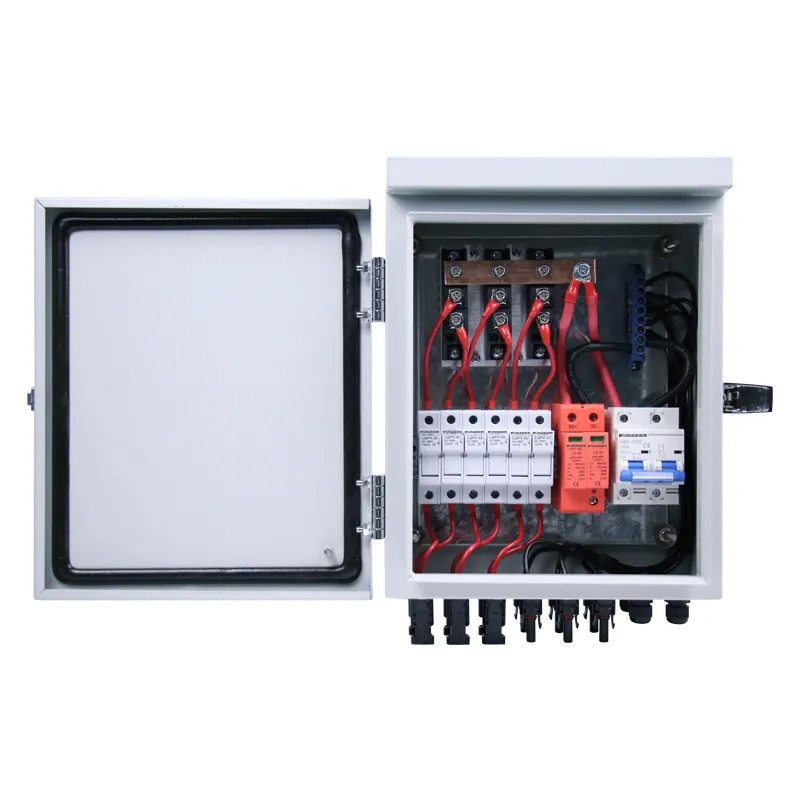Choosing the Right PV Combiner Box for Residential, Commercial, and Utility-Scale Solar Projects
When designing a solar photovoltaic (PV) system, one of the most important decisions is selecting the appropriate PV combiner box. The requirements for residential rooftops differ vastly from large-scale utility projects. Understanding how to size, configure, and choose the right combiner box is key to a safe, scalable, and cost-effective system.
1. What Is a PV Combiner Box?
A PV combiner box consolidates multiple strings of solar panels into a single DC output. It provides electrical protection (fuses or breakers), surge protection, and sometimes string-level monitoring. The combiner box also simplifies wiring and makes systems more serviceable and scalable.
2. Why Proper Selection Matters
Using an underpowered or over-specified combiner box can lead to:
- 🔴 Poor efficiency due to mismatched voltage/current ratings
- ⚠️ Risk of overheating or fire due to insufficient protection
- 💸 Higher costs from unnecessary features or overdesign
- 🧰 Incompatibility with the inverter or project configuration
3. PV Combiner Box Selection Criteria
- System Voltage: 600V, 1000V, or 1500V DC
- Number of Strings: How many strings need combining?
- String Current: Typically 8A to 20A per string
- Output Current Rating: Total current to inverter
- Environmental Rating: IP65/IP66 for outdoor, NEMA 3/4
- Enclosure Type: Plastic, metal, UV-resistant, fire-rated
- Protection Devices: SPD, fuses or MCBs, disconnect switch
- Smart Features: Monitoring, RS485, Modbus, WiFi
- Compliance: UL, IEC, NEC, TUV, CE certifications
4. Residential PV Combiner Box Selection
Typical System Profile:
- Power: 3kW – 15kW
- Strings: 2 – 4
- Voltage: 600V or 1000V
- Roof-mounted systems
Recommended Features:
- 2-4 input strings
- MC4-compatible inputs and screw-type output terminals
- Preinstalled fuses and SPD
- Wall-mounted IP65 enclosure
- Simple manual disconnect or inline DC switch
Cost Range:
$50 – $120 depending on features and brand
Popular Use Case:
A 6kW rooftop solar system with 3 strings feeding into a 3-in-1-out combiner box with 15A fuses and SPD, connected to a single-phase hybrid inverter.
5. Commercial PV Combiner Box Selection
Typical System Profile:
- Power: 20kW – 500kW
- Strings: 6 – 24
- Voltage: 1000V standard
- Flat rooftop or carport arrays
Recommended Features:
- 6–24 string inputs with fuse protection (10A–20A)
- SPD Class II or higher
- Built-in DC disconnect (optional)
- Integrated string monitoring (optional)
- Outdoor-rated, powder-coated steel or FRP enclosure
Cost Range:
$200 – $800 depending on monitoring and breaker type
Popular Use Case:
A 100kW solar carport with 10 strings feeding into a 10-in-1 combiner box connected to a 1000VDC inverter via 35mm² cable.
6. Utility-Scale PV Combiner Box Selection
Typical System Profile:
- Power: 1MW – 300MW+
- Strings: 16 – 48+ per box
- Voltage: 1500VDC
- Ground-mounted, large solar farms
Recommended Features:
- 32–48 input strings
- 1500VDC operation
- Class I+II SPD
- Smart string-level current sensors (RS485/Modbus)
- Galvanized or stainless steel IP66 enclosures
- Mountable on skid or tracker
- Ventilation or fan-cooled options for hot climates
Cost Range:
$1,000 – $3,000+ depending on complexity
Popular Use Case:
A 50MW solar farm using 1,500VDC architecture, deploying 100+ combiner boxes each combining 32 strings, feeding into centralized power stations with monitoring, arc-fault detection, and SPD.
7. Smart vs. Standard Combiner Boxes
Smart combiner boxes include real-time monitoring features, allowing operators to detect and diagnose issues at the string level. While more expensive, they improve O&M efficiency and are commonly used in commercial and utility projects.
| Feature | Standard Combiner | Smart Combiner |
|---|---|---|
| Monitoring | None | String current, voltage, temperature |
| Communication | — | RS485, Modbus, CAN |
| Cost | Lower | Higher |
| Use Case | Residential, basic commercial | Large commercial and utility |
8. Environmental Considerations
- High-altitude or cold regions require dehumidifying heaters or breathers
- Coastal regions may require anti-corrosion coating
- Hot zones need ventilation or reflective enclosures
9. Installation Guidelines per Project Type
Residential:
- Wall-mount next to inverter
- Keep string count simple (≤4)
- Use MC4 for ease of maintenance
Commercial:
- Mount on array racks or inverter room wall
- Ensure safe access and labeling
- Use junction boxes or conduits for clean routing
Utility-Scale:
- Place on PV skid or concrete pedestal
- Integrate into centralized combiner cabinets
- String layout should match combiner layout
10. Conclusion: One Size Does Not Fit All
PV combiner boxes come in many configurations tailored to system size, location, voltage, and monitoring needs.



